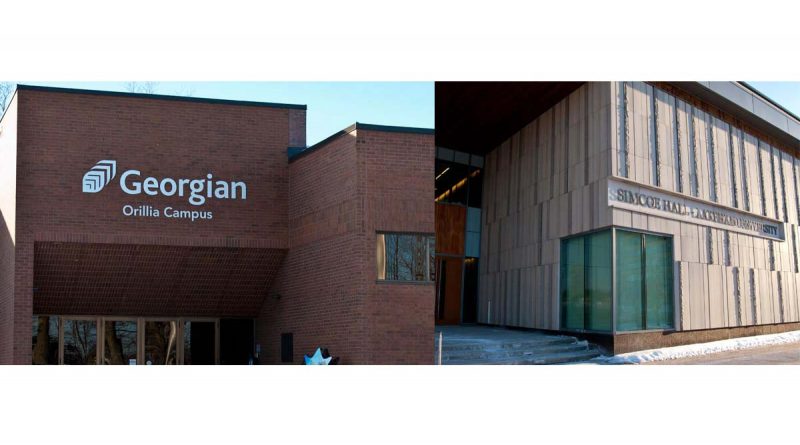Analysis: Post-secondary Cuts Fallout
By John Bleasby – Special to SUNonline/Orillia
There’s been heated rhetoric from both sides of the recent post-secondary tuition and funding announcement made last month by the Ontario government. The government’s case is tuitions are too high in Ontario and need to drop by 10 per cent in order to help low income students. The government also believes grants for tuition through the Ontario Student Assistance Program (OSAP) have been too generous and costly for the province, based on findings of a 2018 auditor general’s report.
While the government’s decision looks appealing at first glance, universities, colleges and students are hitting back hard, arguing changes will hurt both institutions and student enrollment. They say a reduction of grants will increase loan dependence and actually work against lower income students. Students will be classified as dependent if they have been out of high school less than six years, meaning mature students will have parental income factored into the OSAP needs assessment regardless of whether or not they are economically independent, affecting access to grants. And, students from families with annual earnings below $50,000 will no longer receive full OSAP grants to cover their tuition, but will instead cover the tuition in part through loans, thus increasing their debt loads upon graduation.
The rhetoric is getting nasty. Premier Doug Ford recently portrayed post-secondary students as whiners and characterized the activities of student unions as “crazy Marxist nonsense.” Students and government critics decry what they claim is the abandonment of fair access to higher education across income thresholds. Furthermore, some say making student union and activity fees optional instead of compulsory are blatant efforts to reduce student representation and silence opposition. All these they add, are actions undertaken without prior consultation of those affected.
The long-term economic growth of Orillia and Ontario demands a strong knowledge base. It also means a commitment to invest in higher education. Therefore, reconciling the announced changes with the objective of developing an educated workforce capable of competing in the modern world is difficult. How can Orillia, and Ontario, maximize intellectual potential if college and university education is restricted by income?
A $440 Million Revenue Cut Will Affect Orillia
A 10% tuition cut hits the top line revenue of all Ontario universities and colleges. Tuition fees represent roughly 40% of colleges overall income and 55% of universities. This new cut means a major revenue reduction, estimated at $440 million annually. Since it’s a reduction the government has no plan to replace, it threatens to throw the institution’s finances into limbo. While Ontario’s post-secondary education budget for fiscal 2017/2018 was $6.6 billion, it’s important to remember that the $440 million reduction will not reduce the government’s spending by one penny —it represents a direct loss for post-secondary institutions themselves.
Leading credit rating agency Moody’s has expressed concern saying, “The tuition reduction and ability to opt out of other fees are credit negative for Ontario universities because it will decrease revenue and pressure efforts to balance their budgets.” Moody’s also said some Ontario post-secondary institutions which have attracted significant numbers of higher-paying foreign students might help them make up part of the revenue shortfall. However, Moody’s also said the Lakehead campuses in both Thunder Bay and Orillia have a low reliance on foreign students and are therefore more vulnerable to the tuition cuts.

The drop in revenue could mean reduced programs and job losses. A community like Orillia should be very concerned about collateral damage in the face of significant cuts to local colleges and university campuses — or even worse, a drop in enrollment.
It’s important to understand both Orillia campuses contribute significantly to the well-being of the Orillia. For example, Lakehead’s operations, including their 1,300 full-time registered students and over 200 staff, added an annual economic benefit of $54.7 million to the City, according to information supplied by the university.
The economic activity generated by Georgian’s Orillia campus is similarly impressive. Georgian commissioned a report in 2018 to uncover its local impact, authored by Economic Modeling Specialists International, a leading provider of economic impact studies and labour market data to educational institutions. The report estimates in 2017, Georgian’s Orillia campus, including the more than 1,750 full or part-time students and $11.2 million annual staff payroll, “added $39.1 million in income, approximately equal to 3% of the local region’s (Orillia) total gross regional product (GRP), supporting 448 jobs.” Added to Lakehead’s contribution it’s a pretty significant contribution of more than 6% to the City’s total GRP.
Municipal Planning And Education Institutions
The City of Orillia expected a positive effect when Lakehead and Georgian set up campuses here. Georgian opened an adult training center in Orillia in 1967, and moved to the Orillia Armoury the next year. Programs expanded continuously each year, culminating with the opening of the Memorial Avenue campus in 1980. Ten years later construction began on a new 40,000 square foot facility which, and along with the College’s course offerings, has expanded ever since.
Lakehead first arrived in Orillia in 2006 with the opening its downtown Heritage Place campus. The City of Orillia wanted more, demonstrating its commitment with a $10 million investment of land and cash for Lakehead’s 137,000 square foot West Ridge campus which opened in 2010. Dan Landry, the City’s manager of business retention and expansion and industrial development, explained to SUNonline/Orillia, “Part of the impetus for our striving to have Lakehead come to Orillia was self-serving in terms of making post-secondary education more accessible for both local and Simcoe County students – our numbers were below the provincial average for post-secondary attendance. Orillia worked very hard to get both post-secondary campuses located here.”
The City’s twin goals providing local post-secondary educational opportunities and attracting students from outside the area have been realized. According to information provided by Lakehead, 53% of students moved here from outside Simcoe County. In Georgian’s case, the college reported in 2017, “Around 612 students relocated to Simcoe County from outside of the region or outside of Canada to attend Orillia Campus. Of the relocated students, 336 relocated to the City of Orillia. A number of students would have left the region if not for Orillia Campus.” The report points to the strong economic importance associated with this. “These relocated and retained students spent money at local businesses to purchase groceries, rent accommodation, and pay for transport.”

Higher Education Part Of Orillia’s Development Strategy
The economic benefits to the City referenced in the Georgian report come in ways beyond spending on food, accommodation and entertainment at local businesses. For example, full-time Lakehead students have made a significant contribution to Orillia’s transportation system over the past few years. Under a new agreement beginning this September, they will pay $120 for a 12-month transit pass for the next five years, Theresa Vandeburgt, Vice-President of the Lakehead University Student Union (LUSU), told SUNonline/Orillia. With 1300 registered fulltime students, that’s an annual contribution of $156,000 (2019 projected, 2018 actual $133, 850). Fortunately for Orillia, that agreement will remain in place. Although the government’s original January announcement included transit passes as an option for students (and fees for several other campus services and activities), Minster of Training Colleges and Universities Marilee Fullerton later tweeted, “Existing mandatory transit passes will remain so under our Student Choice Initiative. Safety of Ontario students is paramount.”
The presence in the community of these two institutions has also added strength to the City’s pitch to businesses Orillia is a good place to invest. “A lot of the city’s economic development background material surrounds the education level available in Orillia and surrounding area,” Landry said. “Therefore, they are important both from an economic and educational standpoint. Negative impact on either of those institutions stands to have a negative impact on our community.”
Part 2: The cuts hit ground zero as students and campus services are affected.
Read the official Ontario government announcement
( Photos By Swartz – SUNonline/Orillia)

John Bleasby has been an freelance writer for over 40 years, with articles appearing in sports, news and special interest publications in Canada and Australia. For the past 4 years, John has been a Contributing Editor and feature writer with Canadian Contractor magazine, an Annex Business Media publication.




